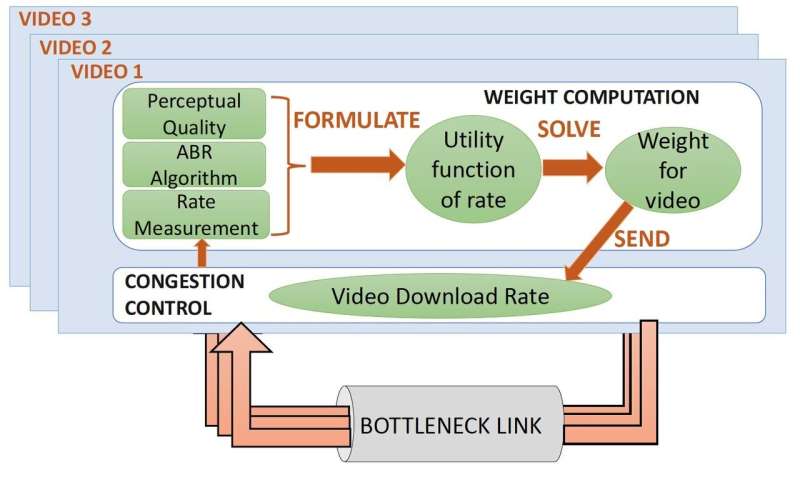Better video streaming when WiFi is scarce

In an era when the average U.S. household has five internet-connected devices, web surfers may often feel like they're always fighting over scraps of WiFi. How can a whole family all binge their favorite shows without somebody's connection slowing to a crawl?
Researchers from MIT's Computer Science and Artificial Intelligence Laboratory (CSAIL) are working on the problem, and have developed a new system called "Minerva" that allows multiple people to stream video over a single network with minimal buffering and pixelation.
The team says that the project could be a game-changer for content providers like Netflix and Hulu that often struggle with keeping all their users happy. Beyond being useful for a single household, Minerva could also benefit people across an entire region who may all be sharing a network bottleneck.
"If five people in your house are all streaming video at once, our system can analyze how the various videos' visuals are affected by download speed," says MIT professor Mohammad Alizadeh, senior author on a related paper that will be presented at the Association for Computing Machinery's Special Interest Group on Data Communications (SIGCOMM) in Los Angeles later this month. "It then uses that information to provide each video with the best possible visual quality without degrading the experience for others."
In real-world tests Minerva reduced rebuffering time by an average of 47 percent—and, up to a third of the time, delivered an improvement in video quality that was the equivalent to a jump in resolution from a 720p to a 1080p television.
Minerva does all this while not requiring any changes to the underlying network infrastructure. A provider like Netflix can deploy Minerva without any changes to home routers or having to coordinate with network service providers. Alizadeh describes the system as a drop-in replacement for the standard TCP/IP protocol that governs internet communication.
"It has all the advantages and simplicity of TCP, while also ensuring that, if multiple videos are competing at a network link that's a bottleneck, the bandwidth will be shared fairly across streams," says Alizadeh.
Anyone who streams videos has probably noticed that there can be big differences in how smoothly any given video runs. Some factors include the device being used, the dimensions of the screen, and even the genre of the video. For example, to deliver the same visual quality, more fast-paced videos like action movies and sports actually require more bandwidth than videos of talking heads or lectures. Streaming a movie on a 4K TV screen, meanwhile, is much more data-intensive than streaming it on a smartphone.
But lead author Vikram Nathan says that traditional protocols don't account for these differences. If two people are sharing 10 megabits per second (Mbps) of bandwidth, the network normally gives each of them half. But if one person is watching grass grow on their smartphone, and another is trying to stream a tennis match on a 4K TV, the sports fan is going to be at a major disadvantage.
"Traditional approaches try to be fair from a technological perspective, but not in terms of somebody's actual happiness or quality of experience," says Keith Winstein, an assistant professor of computer science at Stanford University who was not involved in the project. "What these results demonstrate is that we could all benefit if these systems and protocols were changed to adopt more of the perspective of the people watching the videos."
On top of that, Nathan says that companies like Hulu and Netflix handle the squeeze of limited bandwidth in a coarse and unprincipled manner that does not consider either the video being watched or the extent to which the video has buffered.
The MIT team's system works by having an offline phase where it analyzes different videos to determine how much their visual quality would be improved by giving them different levels of bandwidth. Each user then uses this information when watching their video: users who value bandwidth more are correspondingly more aggressive when claiming their share of the link, while users who would not benefit much from additional throughput back off.
Nathan describes the mechanics of Minerva as an ever-evolving "push/pull" between different videos.
"This process allows the system to allocate resources to the different videos in a way that is fair to them with respect to their visual quality," says Nathan, a graduate student at MIT CSAIL.
Alizadeh and Nathan co-wrote the new paper with graduate students Vibhaalakshmi Sivaraman, Ravichandra Addanki, Mehrdad Khani and Prateesh Goyal.
More information: Vikram Nathan et al. End-to-end transport for video QoE fairness, Proceedings of the ACM Special Interest Group on Data Communication - SIGCOMM '19 (2019). DOI: 10.1145/3341302.3342077



















